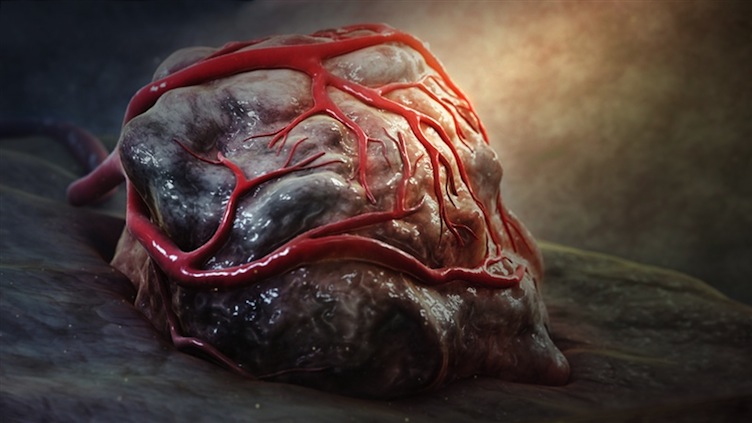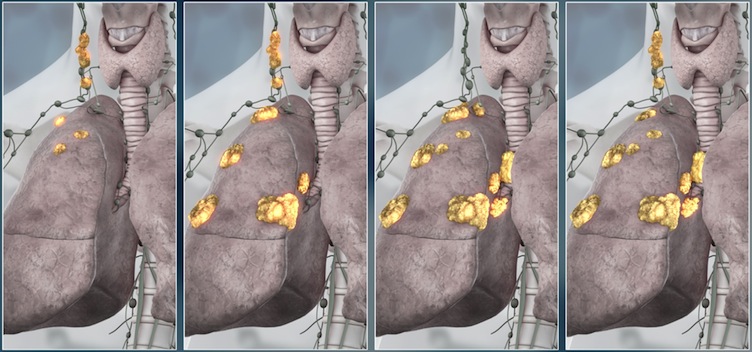3D Medical Animation - Spread of Cancer Cells
This growth eventually results in a lump, which is called a tumor. Depending on the stage of the tumor, it is termed benign (not cancerous) or malignant (cancerous).
3D Medical Illustration - Tumor getting nutrients from the feeder vessels
Primary and Secondary cancers
The cancer that spreads from its place of origin is called a primary cancer. Unfortunately, it’s very easy for the primary cancer cells to spread from the place of origin to other body parts; metastasize. This makes it very difficult to cure the cancer and eventually the prognosis (likelihood of survival) of the patient decreases dramatically.Spread of Primary Cancers
As the tumor continues growing, it starts growing on to the nearby tissues in requirement of more room. In doing so, the tumor prefers the path of least resistance. For example, for very dense tissues such as cartilage, it will be very difficult for tumor to spread into their dense walls and hence will reduce the chances of it being found in that region. The process is termed local invasion. There are 3 ways through which primary cancer spreads:- Pressure through growing tumor:When a tumor starts growing, it pushes through body tissue by the force of its growth. Due to this pressure, it starves the adjacent healthy tissue of blood and oxygen, thus making its growth easier.The shape it assumes usually depends upon the path it takes to grow. The path that offers the least resistance usually forms the longitudinal side of the tumor.
- Through enzymes:Enzymes are a part of the natural healing and protection process of the body. The normal cells use enzymes produced by them to fight of various infections such as bacteria and viruses. They are also used to clear of dead and damaged tissues so that new ones could replace them. However, sometimes, these enzymes along with white blood cells are present in the cancerous cells in large amounts. It is believed that the high concentration of these enzymes is also seminal in the spread of the cancer.
- Cells moving through the tissue.It has been established that cancer cells have a greater ability to move through the tissue compared to the normal cells. This causes the spread of the cancer though direct movement of the cancer cells rather than cell division.
Spread of secondary cancer
More than 90 percent of the deaths caused by cancer are due to metastasis i.e., secondary cancer. It involves the breaking away of the cells from the primary tumor; penetrating through the lymphatic and the blood vessels, circulate in the bloodstream and finally metastasizing (grow in a different place) in normal tissues elsewhere in the body. This type of spread is affected in four different ways:- Blood vessels:After the cells are detached from the primary tumor, they have to push their way through the blood vessel to get into the blood stream. They circulate with the blood stream throughout the body before getting stuck onto another blood vessel, usually a capillary.When they manage to push through the walls of the capillary and onto the tissue of the organ nearby, they start multiplying to grow into a new tumor. In between this journey, the cancer cells have to survive being eliminated by the immune system or being battered around by the circulating blood. Some of them stick on to the blood platelets for extra protection, as this may help them in getting filtered at the next capillary network.
- Lymphatic system:The spread of cancer though the lymphatic system is the same as that in blood circulation. The cells, after getting detached from the primary tumor, travel with the circulating lymph fluid until they get stuck onto small channels in the lymph node. It then starts multiplying there to form a new tumor.

3D Medical Illustration - Spread of Cancer through Lymph Nodes
- Body Cavities:Transcoelomic spread or spread of a malignancy into the body cavities may take place via seeding of peritoneal (covering gut and stomach and other abdominal organs), pleural (covering the lungs), pericardial (covering the heart) or subarchnoid spaces (covering the brain).
- Transplantation of cancer:The carriage of cancer through surgical instruments or through other diagnostic procedures to other parts of the body results in a secondary tumor.
Treatment of cancer
The diagnosis of cancer begins with a thorough physical exam with a detailed study of the medical history of the patient. If a tumor is suspected, various test such as the X-ray, CT, MRI, Ultrasound and Fiber Optic Endoscopy help in determining the location and size of the tumor. Biopsy, where a small part of the cancerous tissue is cut out to be examined, is essential to know the exact nature of the tumor. Surgery is one of the main treatments for cancer. A surgeon simply removes the cancerous cells and tissues from the area affected, which is then examined to see if the patient needs any adjuvant treatment, to reduced the risk of cancer coming back, which is usually chemotherapy or radiotherapy. Chemotherapy works by destroying the dividing cells in the area of the cancerous tissue. Since cancer cells are known to divide much more than normal cells, they are more likely to be killed by chemotherapy.The fact that it kills dividing cells is proof that it has side effects. Unlike other cells in our body, cells in the hair, bone marrow, skin and linings of the digestive system go on diving continuously and are hence affected by chemotherapy. But the damaged is usually repaired after the therapy is over. Radiotherapy involves bombarding radiation on the tumor, which damages the DNA of the cancer cells thus killing them completely. The radiations source maybe outside the body (External radiotherapy), which maybe high energy X Ray beams, cobalt irradiation or particle beams, or inside the body (Internal radiotherapy), which may be radioactive implants placed closed to the tumor.Stage 3 Lung Cancer : All that you need to know
Cancer of the lung, like all cancers, results from an abnormality in the body's basic unit of life, the cell. Normally, the body maintains a system of checks and balances on cell growth so that cells divide to produce new cells only when new cells are needed. Read More..








